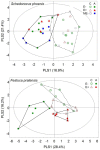Epichloë endophytes alter inducible indirect defences in host grasses
- PMID: 24978701
- PMCID: PMC4076332
- DOI: 10.1371/journal.pone.0101331
Epichloë endophytes alter inducible indirect defences in host grasses
Abstract
Epichloë endophytes are common symbionts living asymptomatically in pooid grasses and may provide chemical defences against herbivorous insects. While the mechanisms underlying these fungal defences have been well studied, it remains unknown whether endophyte presence affects the host's own defences. We addressed this issue by examining variation in the impact of Epichloë on constitutive and herbivore-induced emissions of volatile organic compounds (VOC), a well-known indirect plant defence, between two grass species, Schedonorus phoenix (ex. Festuca arundinacea; tall fescue) and Festuca pratensis (meadow fescue). We found that feeding by a generalist aphid species, Rhopalosiphum padi, induced VOC emissions by uninfected plants of both grass species but to varying extents, while mechanical wounding failed to do so in both species after one day of damage. Interestingly, regardless of damage treatment, Epichloë uncinata-infected F. pratensis emitted significantly lower quantities of VOCs than their uninfected counterparts. In contrast, Epichloë coenophiala-infected S. phoenix did not differ from their uninfected counterparts in constitutive VOC emissions but tended to increase VOC emissions under intense aphid feeding. A multivariate analysis showed that endophyte status imposed stronger differences in VOC profiles of F. pratensis than damage treatment, while the reverse was true for S. phoenix. Additionally, both endophytes inhibited R. padi population growth as measured by aphid dry biomass, with the inhibition appearing greater in E. uncinata-infected F. pratensis. Our results suggest, not only that Epichloë endophytes may play important roles in mediating host VOC responses to herbivory, but also that the magnitude and direction of such responses may vary with the identity of the Epichloë-grass symbiosis. Whether Epichloë-mediated host VOC responses will eventually translate into effects on higher trophic levels merits future investigation.
Conflict of interest statement
Figures




Similar articles
-
Effects of nutrient addition on endophyte-associated grass invasion in a long-term, old-field community experiment.Oecologia. 2021 Jun;196(2):469-482. doi: 10.1007/s00442-021-04933-8. Epub 2021 May 7. Oecologia. 2021. PMID: 33963451
-
Epichloë Endophyte Enhanced Insect Resistance of Host Grass Leymus Chinensis by Affecting Volatile Organic Compound Emissions.J Chem Ecol. 2024 Dec;50(12):1067-1076. doi: 10.1007/s10886-023-01459-6. Epub 2023 Nov 2. J Chem Ecol. 2024. PMID: 37917413
-
Can Aphid Herbivory Induce Intergenerational Effects of Endophyte-conferred Resistance in Grasses?J Chem Ecol. 2022 Dec;48(11-12):867-881. doi: 10.1007/s10886-022-01390-2. Epub 2022 Nov 14. J Chem Ecol. 2022. PMID: 36372818
-
Anti-herbivory defences delivered by Epichloë fungal endophytes: a quantitative review of alkaloid concentration variation among hosts and plant parts.Ann Bot. 2024 Apr 23;133(4):509-520. doi: 10.1093/aob/mcae014. Ann Bot. 2024. PMID: 38320313 Free PMC article. Review.
-
Molecular mechanisms in grass-Epichloë interactions: towards endophyte driven farming to improve plant fitness and immunity.World J Microbiol Biotechnol. 2020 Jun 19;36(7):92. doi: 10.1007/s11274-020-02868-5. World J Microbiol Biotechnol. 2020. PMID: 32562008 Review.
Cited by
-
Aboveground endophyte affects root volatile emission and host plant selection of a belowground insect.Oecologia. 2015 Feb;177(2):487-97. doi: 10.1007/s00442-014-3104-6. Epub 2014 Oct 5. Oecologia. 2015. PMID: 25284612
-
Heritable Epichloë symbiosis shapes fungal but not bacterial communities of plant leaves.Sci Rep. 2019 Mar 27;9(1):5253. doi: 10.1038/s41598-019-41603-5. Sci Rep. 2019. PMID: 30918316 Free PMC article.
-
Symptomless endophytic fungi suppress endogenous levels of salicylic acid and interact with the jasmonate-dependent indirect defense traits of their host, lima bean (Phaseolus lunatus).J Chem Ecol. 2014 Jul;40(7):816-25. doi: 10.1007/s10886-014-0477-2. J Chem Ecol. 2014. PMID: 25015691
-
Small volatile lipophilic molecules induced belowground by aphid attack elicit a defensive response in neighbouring un-infested plants.Front Plant Sci. 2023 Jun 23;14:1154587. doi: 10.3389/fpls.2023.1154587. eCollection 2023. Front Plant Sci. 2023. PMID: 37426972 Free PMC article.
-
Ergot Alkaloids of the Family Clavicipitaceae.Phytopathology. 2017 May;107(5):504-518. doi: 10.1094/PHYTO-12-16-0435-RVW. Epub 2017 Mar 29. Phytopathology. 2017. PMID: 28168931 Free PMC article. Review.
References
-
- Clay K, Schardl CL (2002) Evolutionary origins and ecological consequences of endophyte symbiosis with grasses. Am Nat 160: s99–s127. - PubMed
-
- Saikkonen K, Lehtonen P, Helander M, Koricheva J, Faeth SH (2006) Model systems in ecology: dissecting the endophyte-grass literature. Trends Plant Sci 11: 428–433. - PubMed
-
- Saikkonen K, Saari S, Helander M (2010) Defensive mutualism between plants and endophytic fungi? Fungal Divers 41: 101–113.
-
- Rudgers JA, Afkhami ME, Rúa MA, Davitt AJ, Hammer S, et al. (2009) A fungus among us: Broad patterns of endophyte distribution in the grasses. Ecology 90: 1531–1539. - PubMed
-
- Panaccione DG, Beaulieu WT, Cook D (2014) Bioactive alkaloids in vertically transmitted fungal endophytes. Funct Ecol 28: 299–314.
Publication types
MeSH terms
Substances
LinkOut - more resources
Full Text Sources
Other Literature Sources

